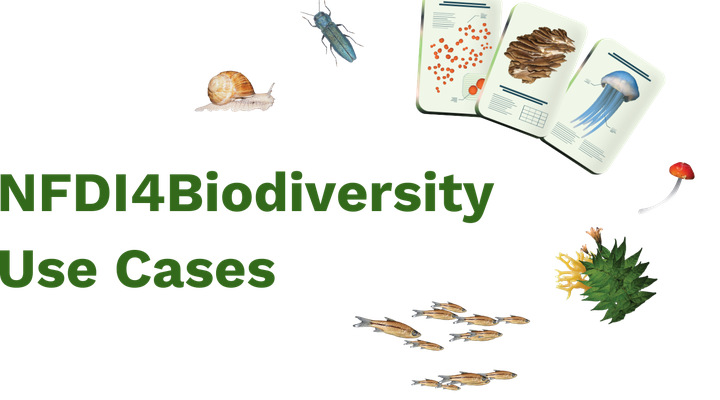Crop Genetics
"Using more than 150,000 seed samples from around 800 genera, we at the IPK are investigating the genetic diversity of cultivated and wild plants and the processes that led to their development. We contribute this knowledge to NFDI4Biodiversity. Research needs this diversity of data so that it can master challenges such as climate change."
Uwe Scholz, Leibniz Institute of Plant Genetics and Crop Plant Research (IPK)
About the Leibniz Institute of Plant Genetics and Crop Plant Research (IPK)
The Leibniz Institute of Plant Genetics and Crop Plant Research (IPK) is dedicated to basic and application-oriented research on crop plants. Its work focuses on the conservation, research and utilization of the genetic diversity of important crop plants. The operation of an ex-situ gene bank plays a central role in this. This gene bank makes it possible to preserve valuable seeds outside their natural habitat in order to maintain genetic diversity. The seeds are carefully stored in glass jars under controlled conditions and are cultivated when it is necessary to preserve seed quality, for example to ensure germination. At the IPK, this valuable resource is combined with research approaches in the fields of genome research, molecular plant biology, systems biology, bioinformatics and modeling. The result is an interplay of genetic conservation and innovative research that both deepens our understanding of genetic diversity and opens up new avenues for the breeding and use of cultivated plants.
At the IPK, this valuable resource is combined with research approaches in the fields of genome research, molecular plant biology, systems biology, bioinformatics and modeling. The result is an interplay of genetic conservation and innovative research that both deepens our understanding of genetic diversity and opens up new avenues for the breeding and use of cultivated plants.

The Use Case
How we work together in NFDI4Biodiversity
In line with the general aim of the National Research Data Infrastructure (NFDI) to make research results permanent, structured and freely accessible, the IPK is already actively involved in various initiatives. These include participation in the consortia FAIRagro and DataPLANT. In addition to the NFDI4Biodiversity consortium, which promotes both this central idea and genetic diversity in the context of biodiversity, the IPK is also active in the German Network for Bioinformatics Infrastructure (de.NBI), which provides the NFDI4Biodiversity consortium with the de.NBI cloud for the development of the RDC. This makes the IPK not only a data center, but also a data and service provider.
The common goal
The aim of the use case is to integrate the biodiversity of the IPK's plant genetic resources (PGR) into the Research Data Commons (RDC) in order to enable analyses with or the networking of this data. In addition, access to tools is also to be facilitated. In addition to web applications for displaying genotypic and phenotypic data, workflows are also offered that enable the imputation of genotypic data or the genome-wide association of phenotypic to genotypic data.
The focus of these developments is on crops such as wheat, barley, oats and beans. However, the tools and workflows developed can also be used for other species and can therefore also be applied in the broader biodiversity community of NFDI4Biodiversity.
Standardization and processing of phenotypic data
Eine zentrale Rolle bei der Aufbereitung phänotypischer Daten und zur Weiterverwendung pflanzengenetischer Ressourcen ist der MIAPPE-Standard – ein Leitfaden, der Nutzenden dabei hilft, Daten über pflanzengenetische Ressourcen so zu ordnen, damit sie leichter genutzt und weiterverarbeitet werden können. Das IPK hat für die Arbeit mit diesem Standard schon vor einiger Zeit ein einfach zu bedienendes Programm entwickelt: den ISA-Wizard. Mit ihm können Forschende ganz einfach die benötigten Informationen des MIAPPE-Standards im ISA-Format erstellen. Zusätzlich arbeitet das IPK auch mit anderen Akteuren an der Weiterentwicklung der BrAPI-Spezifikation. BrAPI ist eine standardisierte RESTful-Web-Service-API-Spezifikation, die die Kommunikation von Pflanzenzüchtungsdaten ermöglicht und somit Interoperabilität zwischen verschiedenen Anwendungen schafft.
Previous work and next steps
Aktuell wird noch weiter an der Entwicklung von Services und Workflows gearbeitet und das Konzept wurde bereits in einem ersten RDC-Piloten namens MIRA umgesetzt. Dieser Service ermöglicht es, phänotypische Daten, die nach dem MIAPPE-Standard strukturiert sind, aus einem Annotated Research Context (ARC) als BrAPI-Server bereitzustellen. Sind die Daten über BrAPI standardisiert abrufbar, wird der programmatische Zugang und somit die Nutzung vereinfacht. Dies ermöglicht es, in weiteren Schritten bestehende oder neu entwickelte Tools über die Schnittstelle anzubinden. Im Zuge eines Forschungsaufenthaltes wurde zusammen mit dem James Hutton Institute mit brapi2arc eine Anwendung entwickelt, die es erlaubt, Beobachtungen von der Phänotypisierungs-App GridScore über BrAPI in einen ARC abzulegen, was die standardisierte Erhebung neuer Daten erleichtert.
Further info
Contact
Would you like to find out more about this Use Case? You can find contact persons here.
Use Case manager (NFDI4Biodiversity)
Sarah Fischer (fischer.sarah@fbn-dummerstorf.de)
Use Case partners (IPK)
Uwe Scholz (scholz@ipk-gatersleben.de)
Manuel Feser (feser@ipk-gatersleben.de)
Publications on the subject
Artikel
Feser, M., König, P., Fiebig, Anne, A. et al. (2022): On the Way to Planet Data Commons. Journal of Integrative Bioinformatics: 19(4)20220033, https://doi.org/10.1515/jib-2022-0033
Research Stay Report
Feser, M., & Raubach, S. (2024). Connecting Dots: Creating a Bridge Between Phenotypic Data Collection Tools and ARC using BrAPI. Zenodo. https://doi.org/10.5281/zenodo.13740520
Preprint
Improving Metadata Collection and Aggregation in Plant Phenotyping Experiments with MIAPPE Wizard and DataPLANT (Daniel Arend, Sebastian Beier, Dominik Brilhaus, Hannah Dörpholz, Manuel Feser, Kevin Frey, Patrick König, Oliver Maus, Dennis Psaroudakis, Cristina Martins Rodrigues, Andrea Schrader, Elisa Senger, and Heinrich Lukas Weil), 2023. BioHackrXiv, https://doi.org/10.37044/osf.io/ekhdw
Preprint
BioHackEU23 report: Enabling continuous RDM using Annotated Research Contexts with RO-Crate profiles for ISA (Sebastian Beier, Timo Mühlhaus, Cyril Pommier, Stuart Owen, Dominik Brilhaus, Heinrich Lukas Weil, Florian Wetzels, Gavin Chait, Daniel Arend, Manuel Feser, Gajendra Doniparthi, Jonathan Bauer, Sveinung Gundersen, and Pável Vázquez), 2024. BioHackrXiv, https://doi.org/10.37044/osf.io/7y2jh
Preprint
BioHackEU24 report: Creating user benefit from ARC-ISA RO-Crate machine-actionability & Increasing FAIRness of digital agrosystem resources by extending Bioschemas (Sebastian Beier, Daniel Arend, Daniel Bauer, Marco Brandizi, Dominik Brilhaus, Eli Chadwick, Vera Clemens, Michael R. Crusoe, Manuel Feser, Jonas Grieb, Xiaoming Hu, Abigail Miller, Timo Mühlhaus, Stuart Owen, Maja Rey, Gabriel Schneider, Julian Schneider, Kevin Schneider, Heinrich Lukas Weil, and Florian Wetzels), 2025. BioHackrXiv, https://doi.org/10.37044/osf.io/x9d6b_v1
Preprint
Simplifying and Standardizing the Creation of Data Use Agreements for Life Sciences and Beyond - BH Germany2024 (Manuel Feser, Sebastian Beyvers, Daniel Arend, Constantin Breß, Maria Hansen, Christian Henke, Stephan Lesch, Carmen Scheuner, and Heinrich Lukas Weil), 2025. BioHackrXiv, https://doi.org/10.37044/osf.io/83apv_v1
Discover other use cases
What is the potential of NFDI4Biodiversity? This is illustrated by our use cases: real-life projects in which we develop solutions for better data management and provision.

Dragonfly Atlas
Around two million dragonfly data, which should also be available to research and nature conservation – this is what we are working on with the dragonflies of the GdO.

Land Use Monitor
Visualisable long-term data on land use can enrich biodiversity research enormously. Together with the IOER, we are integrating them into NFDI4Biodiversity.

Fish Atlas
The GfI's fishologists collected more than 100,000 data sets on regional fish species. Together we are making them easier to find and thus more accessible.